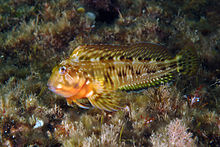Combtooth blenny
| Combtooth blennies | |
|---|---|

| |
| Scartella cristata | |
| Scientific classification | |
| Domain: | Eukaryota |
| Kingdom: | Animalia |
| Phylum: | Chordata |
| Class: | Actinopterygii |
| Order: | Blenniiformes |
| Family: | Blenniidae Rafinesque, 1810 |
| Subfamilies | |

Combtooth blennies are
Description
The body plan of the combtooth blennies is archetypal to all other blennioids; their blunt heads and eyes are large, with large continuous dorsal fins (which may have three to 17 spines). Their bodies are compressed, elongated, and scaleless; their small, slender pelvic fins (which are absent in only two species) are situated before their enlarged pectoral fins, and their tail fins are rounded. As their name would suggest, combtooth blennies are noted for the comb-like teeth lining their jaws.
By far the largest species is the
Habitat and behaviour
Generally
One exceptional group of combtooth blennies deserves special mention: the so-called

Some combtooth blennies form small groups, while others are solitary and territorial. They may be either

In some species, the eggs may remain in the oviduct of the female until hatched. The fry of some species undergo an 'ophioblennius' stage, wherein the fish are pelagic (i.e., inhabiting the midwater) and have greatly enlarged pectoral fins and hooked teeth.
Classification
This family is currently divided into two subfamilies and approximately 58 genera and 397 species.[1]
The following genera are classified within the family Blenniidae:[2][3]
- Subfamily Gill, 1859
- Aidablennius Whitley, 1947
- Alloblennius Smith-Vaniz & Springer, 1971
- Alticus Lacepède, 1800
- Andamia Blyth, 1858
- Antennablennius Fowler, 1931
- Atrosalarias Whitley 1933
- Bathyblennius Bath, 1977
- Blenniella Reid, 1943
- Chalaroderma Norman, 1944
- Chasmodes Valenciennes, 1836
- Cirripectes Swainson, 1839
- CirrisalariasSpringer, 1976
- CoryphoblenniusNorman, 1944
- CrossosalariasSmith-Vaniz & Springer, 1971
- Dodekablennos Springer & Spreitzer, 1978
- Ecsenius McCulloch, 1923
- Entomacrodus Gill, 1859
- Exallias Jordan & Evermann, 1905
- J.L.B. Smith, 1959
- HirculopsJ.L.B. Smith, 1959
- Hypleurochilus Gill, 1861
- Hypsoblennius Gill, 1861
- Istiblennius Whitley, 1943
- Lipophrys Gill, 1896
- Litobranchus Smith-Vaniz & Springer, 1971
- Lupinoblennius Herre, 1942
- Medusablennius Springer, 1966
- Microlipophrys Almada, Almada, Guillemaud & Wirtz, 2005
- Mimoblennius Smith-Vaniz & Springer, 1971
- NannosalariasSmith-Vaniz & Springer, 1971
- Ophioblennius Gill, 1860
- Parablennius Miranda Ribeiro, 1915
- Parahypsos Bath, 1982
- Paralticus Springer & Williams, 1994
- PereulixiaJ.L.B. Smith, 1959
- Praealticus Schultz & Chapman, 1960
- Rhabdoblennius Whitley, 1930
- Salaria Forsskål, 1775
- Salarias Cuvier, 1816
- Scartella Jordan, 1886
- Scartichthys Jordan & Evermann, 1898
- Stanulus J.L.B. Smith, 1959
- Subfamily Blenniinae Rafinesque, 1810
- Adelotremus Smith-Vaniz & Rose, 2012
- Aspidontus Cuvier, 1834
- Blennius Linnaeus, 1758
- Enchelyurus Peters, 1868
- Haptogenys Springer, 1972
- Laiphognathus J.L.B. Smith, 1955
- Meiacanthus Norman, 1944
- Oman Springer, 1985
- Omobranchus Valenciennes, 1836
- Omox Springer, 1972
- Parenchelyurus Springer, 1972
- Petroscirtes Rüppell, 1830
- PhenablenniusSpringer & Smith-Vaniz, 1972
- Plagiotremus Gill, 1865
- Spaniblennius Bath & Wirtz, 1989
- Xiphasia Swainson. 1839
Timeline

See also
References
- Sepkoski, Jack (2002). "A compendium of fossil marine animal genera". Bulletins of American Paleontology. 363: 1–560. Archived from the original on 2009-02-20. Retrieved 2011-05-19.
- ISBN 978-1-118-34233-6. Archived from the originalon 2019-04-08. Retrieved 2019-02-23.
- ^ Froese, Rainer, and Daniel Pauly, eds. (2013). "Blenniidae" in FishBase. February 2013 version.
- ^ Smith-Vaniz, W.F. & Rose, J.M. (2012): Adelotremus leptus, a new genus and species of sabertooth blenny from the Red Sea (Teleostei: Blenniidae: Nemophini). Zootaxa,3249: 39–46.
